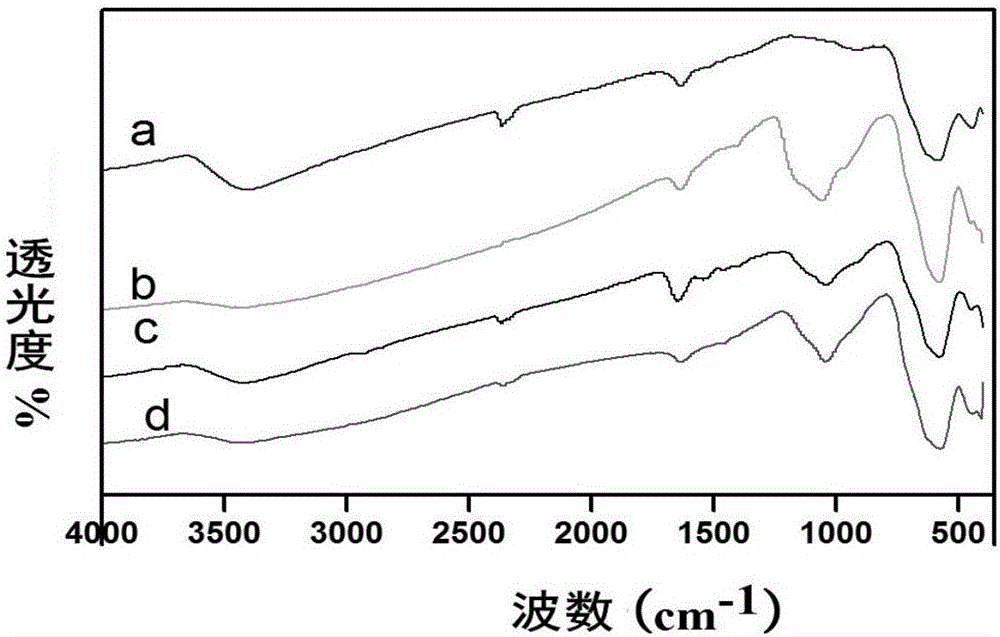Method for rapidly detecting cronobacter sakazakii on basis of PGM and magnetic nano-microspheres
A nano-microsphere, magnetic nano-technology, applied in measurement devices, instruments, scientific instruments, etc., can solve the problems of simplicity, speed and economic impact, tedious preparation of sucrose invertase-labeled antibodies, affecting the accuracy of detection results, etc.
- Summary
- Abstract
- Description
- Claims
- Application Information
AI Technical Summary
Problems solved by technology
Method used
Image
Examples
Embodiment 1
[0026] (1) Synthesis of Magnetic Silica Nanospheres
[0027] Synthesis of Magnetic Fe by Chemical Co-precipitation 3 o 4 , take FeCl 2 4H 2 O (1.35mM) was dissolved in a three-necked flask filled with 70mL of distilled water, under N 2 Stir vigorously under protection, then quickly add FeCl3·6H2O (2.7mM) and 5mL ammonia water into the system, rapidly raise the temperature to 80°C and continue the reaction for 80min. After the reaction, the obtained black precipitate was magnetically separated by a magnet, washed several times with distilled water, and the volume was fixed in 60 mL of distilled water.
[0028] Take the above Fe 3 o 4 Put 30 mL of the solution in a 250 mL flask, add 60 mL of ethanol and 9 mL of ammonia water to the beaker, mix and stir, then add 50 μL TEOS and 200 μL APTMS, stir and react at 35 °C for 1 h, take out the stirring bar and let stand overnight. It was washed successively with ethanol and distilled water. During each cleaning process, an external
Embodiment 2
[0034] Example 2: Establishment of the method for detecting C. sakazakiisyn by immunomagnetic beads and blood glucose meter
[0035] (1) Determination of the optimal working concentration of immunomagnetic beads
[0036] Take 20 μL, 40 μL, 60 μL, 80 μL, 100 μL, and 120 μL of immunomagnetic beads (IMB) respectively, and add them to 1 mL of C. sakazakiisyn bacterial suspension (10 5 cfu / mL), incubate at 37°C for 45min, adsorb with a magnet for 2min-3min, separate the supernatant and magnetic beads, discard the supernatant, add PBS to wash the suspension, mix well, adsorb with a magnet for 2min-3min, separate the supernatant and Magnetic beads, discard the supernatant, repeat washing 3 times, add 200 μL of nutrient broth culture solution containing 20.0 mmol / L glucose to each tube, and incubate at 37°C for 7 hours, detect and calculate the change of glucose concentration in each culture (ΔC) , ΔC=C 1 -C 2 ,C 1 is the glucose concentration in the 0h culture, C 2 is the gluco
Embodiment 3
[0047] Embodiment 3: the relationship between the amount of change in glucose concentration (ΔC) and the concentration of bacterial solution
[0048] IMB 60μL, added to 1mL with a concentration gradient of 10 1 -10 5 cfu / mL of C. sakazakiisyn bacterial suspension, incubate at 37°C for 45 minutes, absorb with a magnet for 2 minutes, separate the supernatant and magnetic beads, discard the supernatant, add PBS to wash, mix well, absorb with a magnet for 2 minutes, separate the supernatant and magnetic beads Magnetic beads, discard the supernatant, repeat washing 3 times, add 200μL nutrient broth culture solution containing 20.0mmol / L glucose to each centrifuge tube, culture at 37℃ for 7h, detect and calculate the change of glucose concentration in each culture (ΔC), ΔC=C 1 -C 2 ,C 1 is the glucose concentration in the 0h culture, C 2 is the glucose concentration in the 7h culture.
[0049] Under the optimal conditions, after each concentration gradient C. sakazakiisyn sta
PUM
| Property | Measurement | Unit |
|---|---|---|
| Particle size | aaaaa | aaaaa |
Abstract
Description
Claims
Application Information
 Login to view more
Login to view more - R&D Engineer
- R&D Manager
- IP Professional
- Industry Leading Data Capabilities
- Powerful AI technology
- Patent DNA Extraction
Browse by: Latest US Patents, China's latest patents, Technical Efficacy Thesaurus, Application Domain, Technology Topic.
© 2024 PatSnap. All rights reserved.Legal|Privacy policy|Modern Slavery Act Transparency Statement|Sitemap



